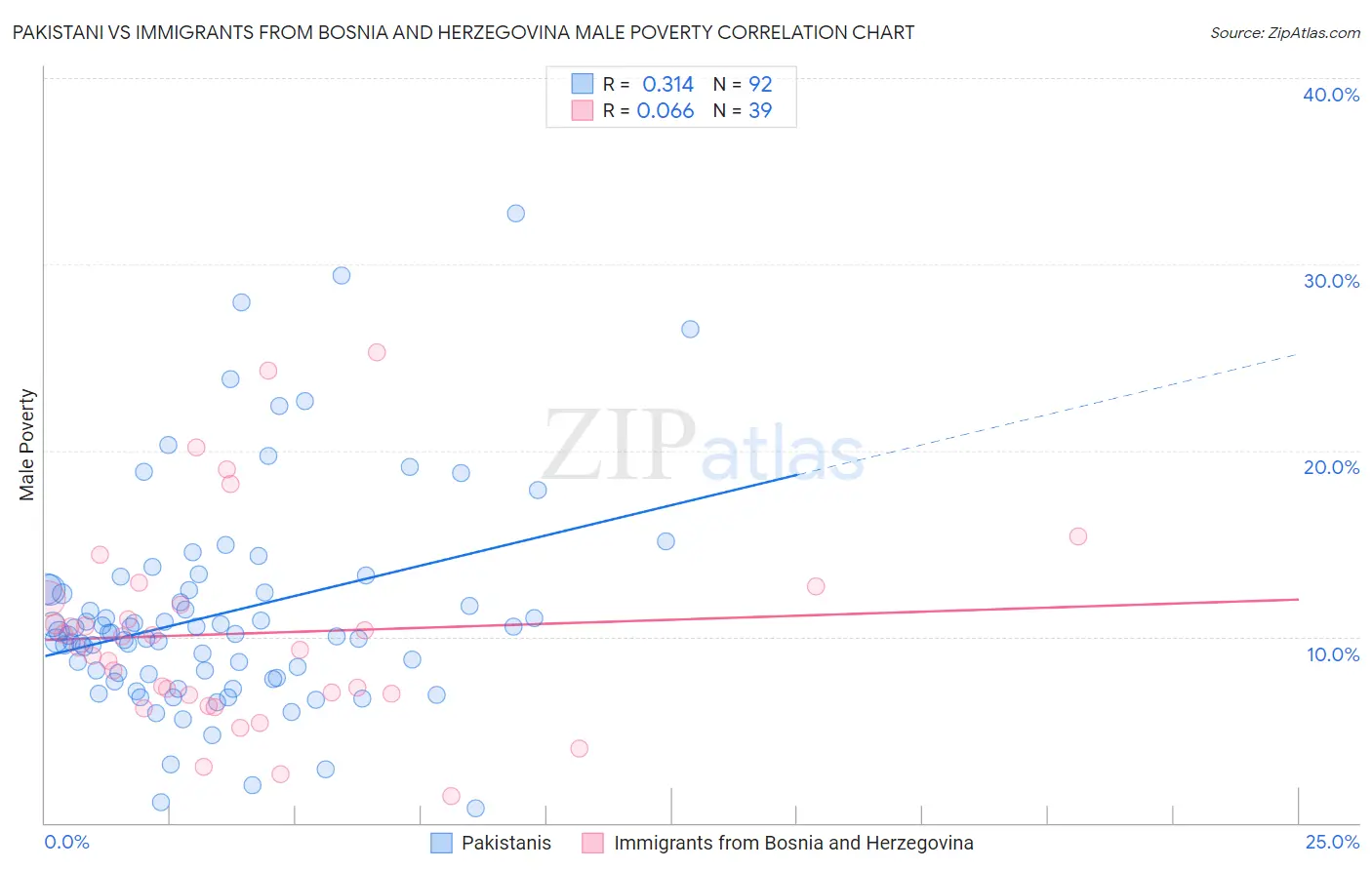Pakistani vs Immigrants from Bosnia and Herzegovina Male Poverty
COMPARE
Pakistani
Immigrants from Bosnia and Herzegovina
Male Poverty
Male Poverty Comparison
Pakistanis
Immigrants from Bosnia and Herzegovina
10.8%
MALE POVERTY
83.0/ 100
METRIC RATING
133rd/ 347
METRIC RANK
11.0%
MALE POVERTY
65.2/ 100
METRIC RATING
153rd/ 347
METRIC RANK
Pakistani vs Immigrants from Bosnia and Herzegovina Male Poverty Correlation Chart
The statistical analysis conducted on geographies consisting of 335,136,890 people shows a mild positive correlation between the proportion of Pakistanis and poverty level among males in the United States with a correlation coefficient (R) of 0.314 and weighted average of 10.8%. Similarly, the statistical analysis conducted on geographies consisting of 156,800,336 people shows a slight positive correlation between the proportion of Immigrants from Bosnia and Herzegovina and poverty level among males in the United States with a correlation coefficient (R) of 0.066 and weighted average of 11.0%, a difference of 2.4%.

Male Poverty Correlation Summary
| Measurement | Pakistani | Immigrants from Bosnia and Herzegovina |
| Minimum | 0.75% | 1.4% |
| Maximum | 32.7% | 25.3% |
| Range | 32.0% | 23.9% |
| Mean | 11.2% | 10.2% |
| Median | 10.2% | 9.4% |
| Interquartile 25% (IQ1) | 7.9% | 6.9% |
| Interquartile 75% (IQ3) | 12.5% | 12.0% |
| Interquartile Range (IQR) | 4.6% | 5.1% |
| Standard Deviation (Sample) | 5.8% | 5.4% |
| Standard Deviation (Population) | 5.8% | 5.4% |
Demographics Similar to Pakistanis and Immigrants from Bosnia and Herzegovina by Male Poverty
In terms of male poverty, the demographic groups most similar to Pakistanis are New Zealander (10.8%, a difference of 0.010%), Brazilian (10.8%, a difference of 0.050%), Immigrants from Israel (10.8%, a difference of 0.36%), Immigrants from Switzerland (10.8%, a difference of 0.62%), and Yugoslavian (10.8%, a difference of 0.78%). Similarly, the demographic groups most similar to Immigrants from Bosnia and Herzegovina are Immigrants from Nepal (11.0%, a difference of 0.23%), Venezuelan (11.0%, a difference of 0.24%), Guamanian/Chamorro (11.0%, a difference of 0.26%), Immigrants from Venezuela (11.0%, a difference of 0.30%), and Armenian (11.0%, a difference of 0.31%).
| Demographics | Rating | Rank | Male Poverty |
| Pakistanis | 83.0 /100 | #133 | Excellent 10.8% |
| New Zealanders | 82.9 /100 | #134 | Excellent 10.8% |
| Brazilians | 82.7 /100 | #135 | Excellent 10.8% |
| Immigrants | Israel | 80.9 /100 | #136 | Excellent 10.8% |
| Immigrants | Switzerland | 79.2 /100 | #137 | Good 10.8% |
| Yugoslavians | 78.2 /100 | #138 | Good 10.8% |
| Immigrants | Jordan | 77.5 /100 | #139 | Good 10.8% |
| Tlingit-Haida | 76.1 /100 | #140 | Good 10.9% |
| Immigrants | France | 75.8 /100 | #141 | Good 10.9% |
| Basques | 74.6 /100 | #142 | Good 10.9% |
| Afghans | 71.9 /100 | #143 | Good 10.9% |
| Samoans | 71.8 /100 | #144 | Good 10.9% |
| Immigrants | Germany | 71.6 /100 | #145 | Good 10.9% |
| Syrians | 71.4 /100 | #146 | Good 10.9% |
| Icelanders | 68.5 /100 | #147 | Good 11.0% |
| Armenians | 68.0 /100 | #148 | Good 11.0% |
| Immigrants | Venezuela | 67.9 /100 | #149 | Good 11.0% |
| Guamanians/Chamorros | 67.6 /100 | #150 | Good 11.0% |
| Venezuelans | 67.4 /100 | #151 | Good 11.0% |
| Immigrants | Nepal | 67.3 /100 | #152 | Good 11.0% |
| Immigrants | Bosnia and Herzegovina | 65.2 /100 | #153 | Good 11.0% |